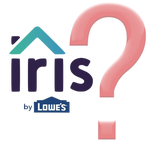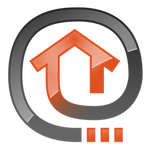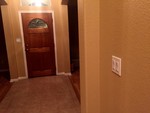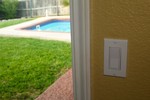
When I think of Home Automation, IKEA never enters my thought process – until now. Some time ago they began producing the TRÄDFRI line of home automation products. Surprisingly enough, they make some pretty interesting stuff.
It’s a good thing they’re ZigBee based, though; their software is of… limited utility.
If you want to use any of their equipment with your pre-existing system (or with, say, Alexa), you’re probably going to need their optional hub.
(note: this has been in my inbox for quite a while, so some of the information may be outdated. I simply forgot to post it way back when…)
The Basics
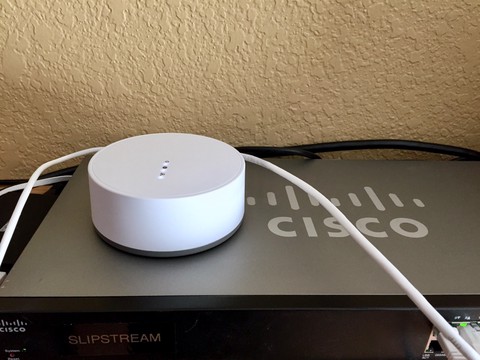 The
TRÄDFRI hub, like most things sold by IKEA, is a fairly plain looking
product. The hardware design is fairly decent; it’s a round unit,
roughly two inches tall, with a removable lid – and there’s room
under that lid for storing excess cable. It even has a couple of
mounting points on the back so you can hang it on the wall. The front
is adorned by a simple vertical line of lights for status.
The
TRÄDFRI hub, like most things sold by IKEA, is a fairly plain looking
product. The hardware design is fairly decent; it’s a round unit,
roughly two inches tall, with a removable lid – and there’s room
under that lid for storing excess cable. It even has a couple of
mounting points on the back so you can hang it on the wall. The front
is adorned by a simple vertical line of lights for status.
The cable storage area is a bigger deal than one might think. It works extremely well for keeping unsightly cables… out of sight. It makes for a fairly neat installation.
Word of warning: do NOT place your hub somewhere you can’t reach it. You’re going to need access to it, and not just during your initial setup.
To control the system, you use a smartphone app. I’m an Apple guy, so I can’t comment on the Android version – but the iPhone version leaves something to be desired. We’ll come back to that.
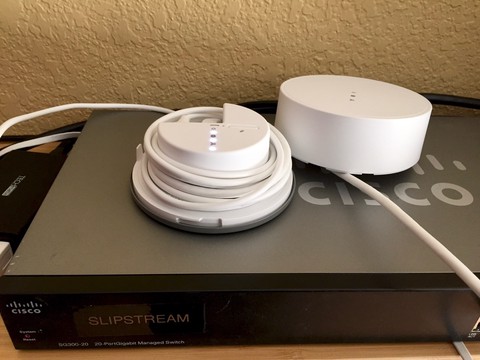 One note on the hardware: as near as I
can tell, it requires a wired ethernet connection to function. For
me this is not an issue; I wire everything anyway. For others,
however, it might not be so easy. If I’m wrong, well, someone do let
me know so I can update this post…
One note on the hardware: as near as I
can tell, it requires a wired ethernet connection to function. For
me this is not an issue; I wire everything anyway. For others,
however, it might not be so easy. If I’m wrong, well, someone do let
me know so I can update this post…
That particular limitation strikes me as unusual in this day and age.
The Setup Process
Setting up the hub is fairly straightforward. Just download the app to your phone, plug the hub in, turn it on, and open the app, which will tell you what to do. Most of the fun stuff is handled by a scan of the QR code on the bottom of the device; you’ll also need to enter the security code you’ll find there.
Discovery-wise, it uses some form of broadcast query (I’ve not investigated this) to locate the hub on your network. But what happens if, like me, you have all your HA gear in a different subnet than your phone?
Well, you wait ten seconds or so for it to time out, and then it will offer you a link that allows you to enter the IP address by hand. It’s not ideal, but it’s better than a number of other bits of hardware that don’t have workarounds for this sort of thing.
Once that’s done, you’re set. The phone app will recognize the hub, and it will walk you through adding your first devices.
Adding Devices
I’m new to ZigBee. I don’t have a Hue or anything else of that sort. I don’t think IKEA’s method is related to ZigBee at all, but it certainly is… interesting.
I’m not sure yet if that’s a good thing.
In order to do anything useful with the TRÄDRFI, you must first add a remote to the system – which IKEA refers to as a “Steering Device”. I don’t see a way to add non-input devices to the system without that. I don’t know why they chose to do it that way, but they did.
Why they chose the term “Steering Device” is, and will probably remain, a mystery. Id’ve settled for “Remote Control”, or even “Input Device”…
Once you have a remote, however, the TRÄDFRI equivalent of Z-Wave inclusion is mostly handled by the remotes, which is pretty nifty. It’s a little more complicated than including a Z-Wave device is with most hubs, but it’s not too bad. The mobile app will walk you through it.
First, you tell the app to add a new device; then you tell it what kind of device and what type of remote you’re going to use to include it. From there, the app will give you explicit instructions for pairing your device with your TRÄDRFRI hub, which is, in general, “hold the remote close and hold the button down.”
When the device is successfully recognized, lights will flash and your phone will update to show you the new device. It’s that easy; adding ten devices will probably take just about as many minutes, most of it waiting while you’re standing there holding a button.
Organization
The TRÄDFRI app’s organization scheme seems, for the most part, to be a way of associating remote controls with the devices they control. I’m sure there’s also some utility through an Alexa skill and other similar features, but I’ve not looked – in my system, all of that is done through OpenHAB anyway.
When you add each remote to the system, the app will automatically create a Room that goes with the remote. You can name the room, and it appears that each target device you add, will be added to the room associated with the remote you used to pair it. It’s pretty simple, really.
The biggest upside to this is that changing what is controlled by which remote is extremely easy; simply open up the app, grab a device, and drag it to another room. The hub will update all the associations (both in the remote and the devices), and you’re set.
The one downside: want multiple groups of devices and multiple remotes in a single physical room? You’ll need to add multiple “Rooms” in the app.
They may as well have renamed “rooms” to “groups”, like everyone else uses; it would have been more accurate.
Controlling Stuff
Overall, the utility factor of the application is low. The only unexpected thing is that it gives you a list of dimmer sliders for entire rooms by default. If you dig into the rooms you can get a list of dimmers to control each light individually.
And that’s about it.
Of course, you also have the remotes you added earlier, and those work just as well for that function. For me, I much prefer to use one of the remote controls to control a group of lights; it’s just too much trouble to pull out my phone and open the app when there’s a remote nearby. Or Alexa to yell at…
You can also use the hub’s API, of course, which is the only reason I have the hub in the first place (the devices are apparently compatible with Hue hubs, but I don’t currently have one of those). Which leads us to…
Using It With OpenHAB
Surprisingly enough, OpenHAB actually works with TRÄDFRI out of the box (at least in 2.2.x, which is what I’m currently running). Simply add the TRÄDFRI binding, give it the hub’s IP address and security code, and off you go. It picked everything up with no trouble.
I will note, however, that you’ll need the latest version of OpenHAB to use the latest IKEA devices (like their smart outlet). The version I have is behind the times, so to speak. And I haven’t had the time to upgrade because they’re in the process of changing the way Z-Sticks are recognized, which (in the latest release candidate) is going to require me to more or less start over by removing and re-adding my entire Z-Wave network to the system.
The people behind OpenHAB do a wonderful job of making upgrades seamless.
That was sarcasm, if you couldn’t tell…
End of rant.
Anyway, once you’ve got your hub bound, you can simply add the devices that show up in your Inbox, just like always. They just work, which is what you would expect. I’ve had no problems so far.
The Catch
So far this sounds pretty good, right? Inexpensive control options, a hub that works, a mobile app, and so forth. No surprises, right?
I have had exactly one annoyance with this system, and it’s a serious one if you have any intention of using the mobile app.
For reasons that I’ve not quite been able to characterize, your mobile app will randomly… forget… about your hub. It claims something about security or something of that sort. You open the app and it says, “Sorry, you need to log back in to your hub!”
Unfortunately, that login process involves going to the hub – physically – and re-scanning the QR code and re-entering the security code (so very conveniently placed on the bottom of the unit).
An-noy-ing!
To make matters worse, that pretty much rules out making use of those nice mounting holes to mount the thing anywhere out of reach. You’d end up having to get out a step ladder every few times you used the mobile app. This is NOT a good experience.
I live in hope that they will fix this with some future release of the app – as well as adding the “manually enter the IP address link” in a place where you can bypass the timeout for that. It would make my life somewhat simpler.
In the mean time, I’ll continue to control the thing exclusively through my main system. It just works better, and I don’t have to fiddle with my phone.
Conclusion
Even with the minor annoyances, I’ve been pretty happy with the system. The remote controls are extremely responsive. The integration with OpenHAB is pretty darn good. And while the mobile app leaves something to be desired, it isn’t really necessary anyway.
If you’re looking for an inexpensive entry into home automation, this might be a good place to start for you. They have a reasonable range of equipment that covers most of the basics. It’s easy enough to use.
And if you really, really hate their hub, you can apparently use their devices with a Hue hub anyway. Not that I’ve tried.
One last note: the reason I bought this at all was to use it with their LED drivers. Their STRÖMLINJE line of slimline under-cabinet lighting is absolutely wonderful, and the TRÄDFRI drivers are designed to work with it. That means I have full remote control of my counter lighting, complete with dimming.
Totally worth it.
